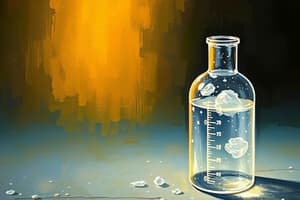Podcast
Questions and Answers
According to the Arrhenius definitions, an acid is a substance that produces which ion when dissolved in water?
According to the Arrhenius definitions, an acid is a substance that produces which ion when dissolved in water?
- Sulfate ion (SO4^2-)
- Nitrate ion (NO3-)
- Hydroxide ion (OH-)
- Hydrogen ion (H+) (correct)
What is the main contribution for which Svante Arrhenius won the Nobel Prize in Chemistry?
What is the main contribution for which Svante Arrhenius won the Nobel Prize in Chemistry?
- Definition of salts
- Discovery of hydroxide ions
- Introduction of the Brønsted-Lowry definitions
- Understanding of ions in salt solutions (correct)
In Arrhenius' doctoral thesis, what revolutionary idea did he propose about salt solutions and their ability to conduct electricity?
In Arrhenius' doctoral thesis, what revolutionary idea did he propose about salt solutions and their ability to conduct electricity?
- Salts dissociate into hydrogen ions and oxygen ions
- Salts dissociate into anions and cations (correct)
- Salts dissociate into positive and negative ions
- Salts dissociate into metallic ions and non-metallic ions
What was considered 'outrageous' about Arrhenius' idea on electricity conduction in salt solutions when he proposed it in 1884?
What was considered 'outrageous' about Arrhenius' idea on electricity conduction in salt solutions when he proposed it in 1884?
What is the main difference between Brønsted-Lowry acids/bases definitions and Arrhenius definitions?
What is the main difference between Brønsted-Lowry acids/bases definitions and Arrhenius definitions?
According to the Brønsted-Lowry theory, what does a Brønsted-Lowry base do?
According to the Brønsted-Lowry theory, what does a Brønsted-Lowry base do?
How does the Brønsted-Lowry acid-base theory differ from the Arrhenius theory?
How does the Brønsted-Lowry acid-base theory differ from the Arrhenius theory?
What determines if an acid or base is classified as strong or weak?
What determines if an acid or base is classified as strong or weak?
In terms of the Brønsted-Lowry theory, what distinguishes an organic acid from an inorganic acid?
In terms of the Brønsted-Lowry theory, what distinguishes an organic acid from an inorganic acid?
How do strong acids and bases differ from weak acids and bases?
How do strong acids and bases differ from weak acids and bases?
Flashcards are hidden until you start studying




